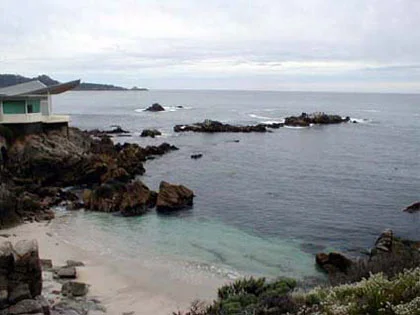North Monastery
Monastery is a long beach located just north of Point Lobos. There are two distinct sites located here: North Monastery and South Monastery. This page describes the north end. We also have a page about the northern end of the beach.
This site is known for hazardous conditions. The steep slope of the beach results in pounding plunging waves which immediately break onto the sand with a lot of force. Waves that are only knee-high have the potential for knocking you down, so assessing conditions and performing a proper entry is extremely important at this site. There are many opinions regarding the “proper” method for entering this site. Some advocate entering while wearing your fins, while others prefer to don their fins after passing the surf zone. Rather than preach my preference (and risk offending others) I will leave it up to you and your instructor to determine the entry of your choice. But no matter how you prefer to enter, be sure that you observe the surfe before you enter, and time the entry during the smaller sets of waves, and once committed to an entry, pass through the surf zone quickly. If the waves appear large pick another site and return here when conditions calm down. As the photo shows, this site has its calm days, so avoid the questionable days.
There are many reasons why divers enjoy this beach. The large, coarse sand sinks quickly, and that results in better visibility than other sites in the area. Also, a finger of the trench is located only a short surface swim from shore, making deeper dives more accessible than at other shore dives. The close proximity to the trench also increases your chances of seeing unique critters. For example, during one of my dives a gray whale passed by me, and that was only 20 yards from the beach!
The reef is clearly marked by a thick kelp bed on the far northern end of the beach. Enter near this kelp bed, as the waves tend to be smaller in front of the kelp. once in the water, surface swim along the edge of the kelp until you decide to descend. If you prefer a shallower dive you can descend pretty close to shore as the water reaches 20 feet pretty quickly. Dive along the edge of the reef and look for a couple openings in the reef to explore. Avoid diving too far into the reef as conditions can get very surgy if you reach shallow water.
If it’s a deeper dive you are after, continue your dive until you near the washrock that breaks the surface about 60 yards from shore. Descend along some kelp to avoid drifting during descent. Once at the bottom, the depth should be about 40 feet. Navigate along the edge of the reef, and watch your depth! The depth increases very rapidly, with about 10 feet of depth gained every few kicks.

